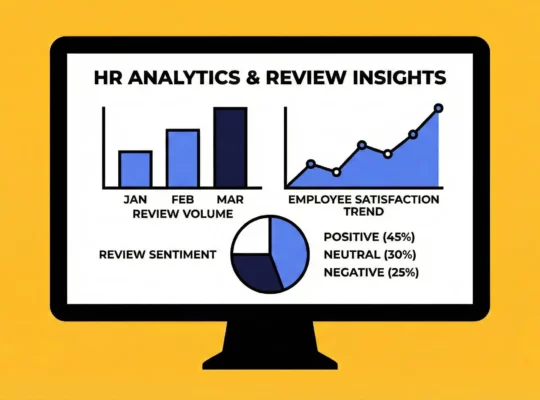Article Summary
Understanding and managing brand reputation is crucial for businesses across all industries. This article delves into various real-world brand reputation management case studies, exploring successful strategies and outcomes. Learn from the experiences of companies like Starbucks, Johnson & Johnson, Domino’s Pizza, and many more to enhance your own brand’s reputation.
Table of Contents
- Overview
- What is Brand Reputation Management?
- Importance of maintaining a positive brand reputation
- Overview of reputation management strategies
- Section 1: Case Study Analysis
- Section 2: Key Lessons and Best Practices
- Final Thoughts
- FAQ
Article Overview
Brand reputation management case studies are essential tools for understanding how to navigate the complexities of maintaining a positive brand image. At review.jobs, we specialize in helping businesses manage their online reputation through strategic interventions and best practices. Whether it’s handling negative reviews or crafting a response to a crisis, understanding real-world examples can provide invaluable insights. This article explores various brand reputation management case studies, offering detailed analysis and key lessons for business leaders, marketing professionals, and public relations experts.
What is Brand Reputation Management?
Brand reputation management involves the strategic process of monitoring, influencing, and maintaining the public perception of a company. It encompasses a wide range of activities, from handling negative reviews to implementing comprehensive crisis management strategies. Effective reputation management ensures that a company remains favorable in the eyes of its customers and stakeholders, regardless of the challenges it faces.
Importance of Maintaining a Positive Brand Reputation
A positive brand reputation is a cornerstone of business success. It fosters customer trust, enhances market competitiveness, and protects against potential crises. Companies with strong reputations can weather negative publicity more effectively and continue to grow even in challenging circumstances. Conversely, a damaged reputation can lead to customer trust rebuilding challenges, financial losses, and long-term damage to a company’s brand image.
Overview of Reputation Management Strategies
Effective reputation management strategies include proactive measures, such as monitoring online reviews and engaging with customers on social media. It also involves reactive strategies, like crisis management and timely communication during negative events. By employing a mix of these strategies, companies can safeguard their reputation and maintain positive relationships with their stakeholders.
Section 1: Case Study Analysis
High-Profile Incidents and Responses
Incident Summaries
Examining incidents from well-known companies offers a clear view of how a reputation crisis can occur. For instance, the Starbucks racial bias incident in 2018 saw the arrest of two African-American men in a Philadelphia store, which sparked widespread outrage. Similarly, Johnson & Johnson’s Tylenol crisis in 1982 involved cyanide-laced capsules causing multiple deaths, leading to a nationwide recall.
Responses and Actions Taken
Companies often take immediate and long-term actions to manage crises. Starbucks‘ response included a public apology from CEO Kevin Johnson and the closure of 8,000 stores for racial bias training. Johnson & Johnson, on the other hand, recalled the Tylenol products and introduced tamper-resistant packaging to prevent future incidents.
Outcomes and Lessons Learned
The outcomes of these actions demonstrate the effectiveness of transparency and proactive measures. Starbucks’ commitment to change and training helped rebuild its reputation, while Johnson & Johnson’s transparent communication and new packaging standards set a precedent for crisis management.
Common Themes in Reputation Management
Timely Communication
Timely communication is crucial in managing reputation crises. Immediate responses help control the narrative and demonstrate the company’s commitment to addressing the issue. For example, during the Volkswagen emissions scandal, the company’s swift communication efforts were pivotal in managing the fallout.
Proactive Measures
Taking proactive measures can prevent potential crises and mitigate damage. Proactive measures include regular monitoring of social media and online reviews, as well as implementing policies that address potential issues before they escalate. Domino’s Pizza’s overhaul of its recipe and technology investments is a prime example of proactive reputation management.
Consistent Messaging
Consistency in brand messaging ensures that all communication aligns with the company’s values and goals. This is essential for maintaining trust and credibility. For instance, Gillette’s masculinity ad faced backlash, but the company maintained consistent messaging, which helped it uphold its stance.
Stakeholder Engagement
Engaging with stakeholders, including customers, employees, and investors, is vital for rebuilding trust and credibility. Stakeholder engagement strategies include open dialogues, regular updates, and involving stakeholders in decision-making processes. This approach was evident in Amazon’s handling of labor practice criticisms, where they focused on maintaining a strong brand appeal.
Leveraging Positive Content
Creating and promoting positive content can overshadow negative publicity and enhance a company’s online presence. Leveraging positive content involves sharing success stories, customer testimonials, and positive news coverage. This tactic was successfully employed by a financial services company that optimized web properties to improve search results and clear negative content.
Section 2: Key Lessons and Best Practices
Timely and Transparent Communication
Importance of Immediate Response
An immediate response can significantly mitigate the impact of a crisis. Quick action shows that the company takes the issue seriously and is committed to resolving it. Immediate response strategies include issuing public statements, addressing concerns on social media, and providing regular updates.
Role of Transparency in Regaining Trust
Transparency builds trust and credibility. Being open about the issue, the steps being taken to address it, and the progress made can help restore customer confidence. This was evident in Samsung’s Galaxy Note 7 crisis, where transparent communication about the recall and refund process helped the company regain trust despite significant financial losses.
Proactive Measures and Crisis Preparation
Importance of Having a Crisis Management Plan
A well-prepared crisis management plan outlines the steps to be taken in the event of a crisis, ensuring a swift and effective response. This plan should include communication strategies, roles and responsibilities, and contingency measures. Crisis management plans are essential for minimizing damage and maintaining business continuity.
Proactive Measures to Prevent Reputation Damage
Proactive measures, such as regular monitoring and stakeholder engagement, can prevent potential crises. Companies should invest in tools and strategies that allow them to detect and address issues before they escalate. For example, BH Management’s use of Widewail’s tools improved review management and customer engagement, showcasing the effectiveness of proactive reputation management.
Consistent Brand Messaging
Maintaining Consistency Across All Communication Channels
Consistency across all communication channels ensures that the company’s message is clear and unified. This includes social media, press releases, and internal communications. Consistent messaging helps maintain a strong brand identity and prevents confusion among stakeholders. Cadbury’s response to the salmonella outbreak focused on consistent messaging around product quality and safety, which helped restore its brand reputation.
Aligning Actions with Brand Values
Aligning actions with brand values reinforces the company’s commitment to its principles. This alignment should be evident in the company’s responses to crises and ongoing communication efforts. Gillette’s handling of the toxic masculinity ad backlash maintained alignment with its brand values, demonstrating the importance of consistency in reputation management.
Engaging with Stakeholders
Importance of Stakeholder Communication
Regular and open communication with stakeholders is crucial for maintaining positive relationships. This includes addressing their concerns, providing updates, and involving them in decision-making processes. Stakeholder communication was key in Amazon’s response to criticisms of its labor practices, where maintaining a strong brand appeal helped mitigate negative sentiment.
Building and Maintaining Positive Relationships with Stakeholders
Building positive relationships with stakeholders involves regular engagement and addressing their needs and concerns. This can include customer feedback programs, employee engagement initiatives, and investor updates. Sloane Automotive Group’s review generation and response management efforts improved customer engagement and regional performance, highlighting the importance of stakeholder relationships.
Leveraging Positive Content
Creating and Promoting Positive Content
Positive content can overshadow negative publicity and enhance a company’s online presence. This includes sharing success stories, customer testimonials, and positive news coverage. Creating and promoting positive content was effective for a financial services company that improved its search results and cleared negative content through optimized web properties.
Displacing Negative Content in Search Results
Displacing negative content involves creating high-quality, positive content that ranks higher in search results. This can push negative content down, making it less visible to users. A financial services company optimized and expanded its web properties to improve search results and maintain a positive online presence, demonstrating the effectiveness of this strategy.
Final Thoughts
Effective brand reputation management is essential for maintaining a positive company image and building customer trust. By learning from real-world brand reputation management case studies, business leaders and professionals can develop robust strategies to protect and enhance their brands. Review.jobs is committed to helping companies navigate these challenges through comprehensive review management services. By applying the lessons and best practices highlighted in this article, businesses can safeguard their reputation and achieve long-term success.
FAQ
What is brand reputation management?
Brand reputation management involves monitoring and influencing how a company is perceived by its customers and stakeholders, ensuring a positive public image.
Why is timely communication important in reputation management?
Timely communication helps control the narrative during a crisis, demonstrating the company’s commitment to resolving the issue and maintaining trust.
What are proactive measures in reputation management?
Proactive measures include regular monitoring, stakeholder engagement, and implementing policies to prevent potential issues before they escalate.
How can positive content improve a company’s online reputation?
Positive content, such as success stories and customer testimonials, can overshadow negative publicity and improve a company’s search results and overall online presence.
What role does stakeholder engagement play in reputation management?
Engaging with stakeholders builds and maintains positive relationships, addressing their concerns and involving them in decision-making processes, which helps rebuild trust and credibility.





